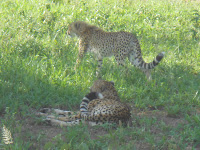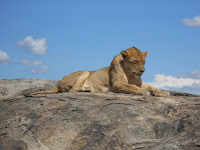For Easter break, Kjirstin and I decided that it was time to visit some of the big national parks in Tanzania. Since we are already living here, it only seems reasonable to take it the opportunities that we can to see as much of Tanzania as we can!
On the Friday before Palm Sunday, we took a 10 1/2 hour bus ride to Arusha. It was very long and uncomfortable. Plus, there was only one ten minute stop for food and bathroom. It was quite a relief to finally arrived in Arusha and got to the hotel where it had been arranged for us to stay.
The next morning we met our guide after breakfast and we were off! On our way to our first national park, Tarangire, we stopped at a tourist shop which was selling Tanzanite among other tourist-y souveniers. Honestly, most of the stuff they were selling was worthless, steryotypical African stuff that does not hardly reflect culture in Tanzania at all. It's really strange being so familiar with the culture and whatnot and being able to distinguish between what is real and what is fake. The Tanzanite, however, was absolutely gorgeous and we really enjoyed looking at all the different pieces that they were selling. It's a beautiful blue stone, but it can change to a purplish color depending on the light. We learned that the darker the color, the higher quality it is and that green color is pretty low quality. It's very expensive because it's such a rare material which is only found in Tanzania. In fact, it's supposed to all run out in the near future. So, I guess if you want some, you'd better buy it quick because it's not going to be around much longer!
After the stop, we continued on to Tarangire National Park. It was a gorgeous park and quite different from Mikumi (which is quite a small park which is nearby). It was very hill-y and green and there were Baobab Trees everywhere! It was really quite stunning with the river flowing through it and herds of elephants roaming about everywhere. We saw our first lion in Tarangire, but it was very far away and it was hard to get a good picture. The most exciting thing about our visit was getting to see a mama cheetah and her baby. They walked right past our car on their hunt for food! It was really quite amazing!
TARANGIRE NATIONAL PARK:


If you can believe this, these are picture of the "tent" that we stayed at in Tarangire. We choose the tent options because they're cheaper than staying in lodges. However, even the tents were nicer than our own home in Morogoro. And the food that we were served was absolutely amazing and VERY western! It was a pretty shocking transition for us to go from life in Morogoro to something so very westernized.


The next day we left Tarangire and made our way towards the Serengeti which is in the NgoroNgoro Conservation Area (NCA). This area include Serengeti, NgoroNgoro Crater, and Oldupai Gorge, as well as surrounding areas in attempt to preserve the natural wonders there.
On our way to Serengeti we stopped at Oldupai Gorge which is where an ancient set of footprints was preserved in the rock. Also, many ancient bones (some of the oldest ever discovered) of man have been discovered in the gorge. We got to see a cast replication of the man or woman who lived 3.5 million years ago. The original has been recovered for preservation purposes. We also got to see many old bones of ancient animals in their museum. It was a nice rest stop and a great time to get up and stretch our legs after sitting for so long.
An interesting note is that when some Germans came to OlduPAI Gorge, they mis-hear the name as OlduVAI Gorge. Thus, in the greater world, it is more commonly known as Olduvai Gorge. However, they really are trying to get the record straight that this is Oldupai Gorge (Oldupai being the local Masai word for the sisal plants which are growing there).
OLDUPAI GORGE:
After the Gorge, we continued on to Serengeti National Park. We were there that evening, the next day, and the morning of the following day. The Serengeti was definitely different from either Tarangire or Mikumi National Parks. Here, the plains stretched on endlessly and gnarled acacia trees were the only trees that were able to grow. The problem, we learned, is that there is a very hard layer of lava which prevents roots from growing deep into the ground, so in most places, there are no trees. The grassy plains were nice because it allowed us to see many animals; even ones which were far away.
Here, we saw many wildebeasts, but they are not migrating right now because they are calving. So as we looked out, we saw thousands of them spread out across the expanse of wilderness. Among them were zebras and various types of antelope which migrate with them.
Here, we also saw a number of birds, hippos, giraffes, elephants, leopards, cheetahs, monkeys, hyenas, buffalo, and tons of lions. We saw at least four prides of lions in the park in addition to others that were traveling alone. We saw one pride that had recently killed a buffalo and we got to watch them eat the meat. We also got to see some of the lions hanging out in the trees where they are able to catch a bit of a breeze to cool down in the hot afternoons.
The weather for the whole trip was pretty spectacular. It was really cool in the evenings (like, enough to want a sheet and in some cases a blanket) and although it warmed up in the afternoons, it wasn't nearly as hot as it's been in Morogoro.
While we were in the Serengeti, we spent one night in the tents (which were not quite as nice at Tarangire, but still quite amazing) and one night in a lodge. I personally preferred the night in the tents because it was so much peaceful and I felt a lot closer to nature.
On our last morning in Serengeti, we took a very early morning drive starting at 6:30am. We returned to the site where the lions had been eating the buffalo the day before and found that there was almost nothing left! The lions had left the site and there was a hyena there trying to pick off the last of the meat from the head and spinal column. We drove for a while and then ended up in a place where there was a small pride of lions in a tree and in the grass nearby at heard of buffalo. We waited for a while until one of the buffalo migrated away from the heard and close to the lions. We got to watch two of the lions chase it, but that buffalo got really scary when it realized that the lions were after it, so they gave up on the chase.
SERENGETI NATIONAL PARK:


Our last stop was NgoroNgoro Crater. Our day began with some excitement as we found ourselves following a lion who was marking his territory. We got to follow this lion for at least 5 - 10 minutes and I was able to get a lot of great pictures!
Of all of the parks I've seen in Tanzania, NgoroNgoro Crater was my personal favorite. It was absolutely stunning! We descended into the crater and found ourselves in what I would describe as an animal's paradise. There were grasslands, a small rainforest, a swamp area, a large lake, and forested areas around the sides and rim of the crater. We saw many animals that we had gotten to see in the other parks in addition to flamingoes and three white rhinos. Our guide told us that there were only 17 remaining in the crater (which is the only place in the world where they live). The three that we saw were quite far away and we could only really see them using the binoculars. But, I did try my best to get a picture of one that was a little bit closer than the others that we saw.
We also got to see another lion who was preparing to leap after a wildebeast. However, the wildebest could kind of see the lion and was being very cautious. Then a jackle (sp?) came and started making a bunch of noise which scared a lot of the animals away, so the lion gave up and came to sit right next to the road. We got some great pictures of her and more lions in the crater!
NGORONGORO CRATER:
Overall, it was a great trip! Although it was a LOT of sitting down, we were able to stand up, even when the car was in motion because the roof popped up. We saw a TON of animals, especially lions, and we got to see the Big Five: elephants, buffalo, lions, leopards, and rhinos. All of the animals are considered very special to see because they were so well hunted in the past. Some of these, like the rhinos are practically extinct. But, park rangers and other workers are doing everything that they can to protect these magnificent animals of Tanzania.
I hope that you've enjoyed my re-telling of our trip and the pictures! I wanted to post more pictures, but I felt like it was getting to be a lot already. If you would like to see more pictures, please check out my facebook page where I've posted a good portion of my pictures!
I know it's a bit late now, but Heri ya Pasaka! (Happy Easter!)
May the Lord Bless You and Keep You,
~Christine
I hope that you've enjoyed my re-telling of our trip and the pictures! I wanted to post more pictures, but I felt like it was getting to be a lot already. If you would like to see more pictures, please check out my facebook page where I've posted a good portion of my pictures!
I know it's a bit late now, but Heri ya Pasaka! (Happy Easter!)
May the Lord Bless You and Keep You,
~Christine





































Serengeti National park is the most famous park in Tanzania. Serengeti is a Masai word which means "Endless Plains".
ReplyDeleteBryce Canyon Events